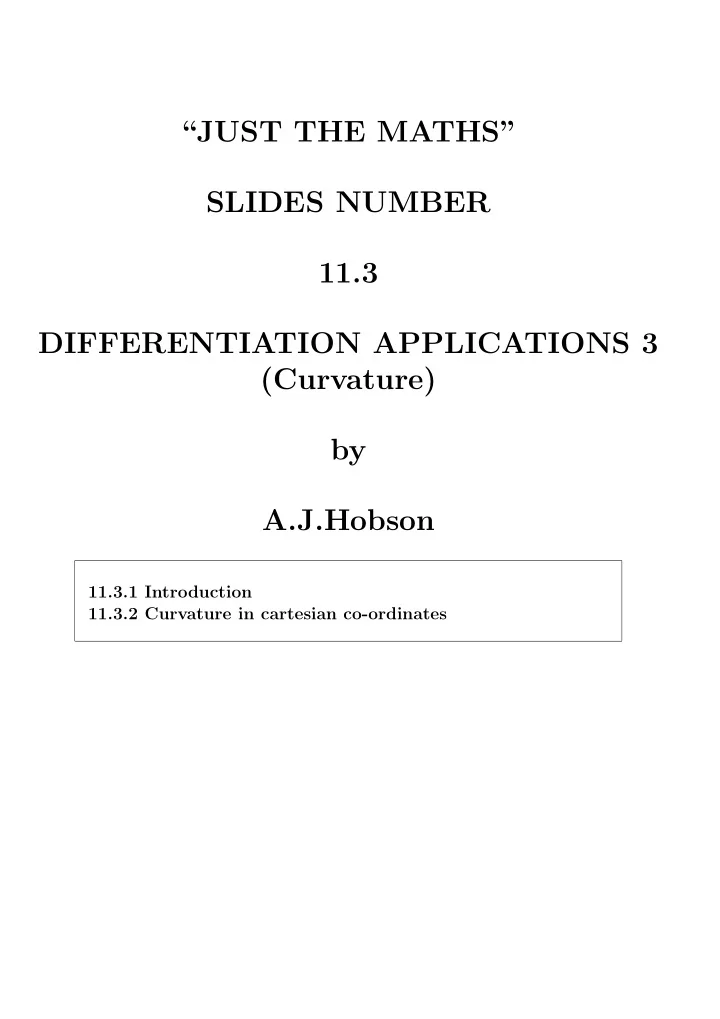

“JUST THE MATHS” SLIDES NUMBER 11.3 DIFFERENTIATION APPLICATIONS 3 (Curvature) by A.J.Hobson 11.3.1 Introduction 11.3.2 Curvature in cartesian co-ordinates
UNIT 11.3 - DIFFERENTIATION APPLICATIONS 3 CURVATURE 11.3.1 INTRODUCTION The “tightness of a bend” on a curve is called its “curvature” . Tight bends have large curvature. Curves may be “concave upwards” ( ∪ ), having posi- tive curvature, or “concave downwards” ( ∩ ), having negative curvature. DEFINITION Let y = f ( x ) be the equation of a curve. � � y � ✻ � P � s � � θ ✲ � x O � � F � � � � � Let θ be the angle made with the positive x -axis by the tangent to the curve at a point, P( x, y ), on it. 1
Let s be the distance to P, measured along the curve from some fixed point, F, on it. Then the curvature, κ , at P, is defined as the rate of increase of θ with respect to s . κ = d θ d s. EXAMPLE Determine the curvature at any point of a circle with radius a . Solution ✂ ✂ y ✂ ✻ ✂ � ✂ � ✂ � PPP ✂ � a ❅ B P ✂ � ❅ δθ � ✂ ❅ F A � ✂ � ✂ � ✂ θ θ + δθ � ✂ ✲ x O Let A be a point on the circle at which the tangent is inclined to the positive x -axis at an angle, θ . Let B be a point (close to A) at which the tangent is inclined to the positive x -axis at an angle, θ + δθ . 2
Let the length of the arc, AB, be δs , where distances, s , are measured along the circle in a counter-clockwise sense from the fixed point, F. δθ is both the angle between the two tangents and the angle subtended at the centre of the circle by the arc, AB. Thus, δs = aδθ, or δθ δs = 1 a. Allowing δθ , and hence δs , to approach zero, we conclude that κ = d θ d s = 1 a. Note: For the lower half of the circle, θ increases as s increases, while, in the upper half of the circle, θ decreases as s increases. 3
The curvature will, therefore, be positive for the lower half (which is concave upwards) and negative for the upper half (which is concave downwards). Summary The curvature at any point of a circle is numerically equal to the reciprocal of the radius. 11.3.2 CURVATURE IN CARTESIAN CO-ORDINATES Given a curve whose equation is y = f ( x ), let P( x, y ) and Q( x + δx, y + δy ) be two neighbouring points on it (separated by a distance of δs along the curve). y Q( x + δx, y + δy ) ✻ δs ✏ ✏✏✏✏✏✏✏✏ δy P( x, y ) ✏ ✏ ✏ δx ✏ θ ✲ x ✏ ✏ O ✏ ✏ ✏ In this diagram, d y δy d x = lim δx = tan θ δx → 0 4
Also, d x δx d s = lim δs = cos θ. δs → 0 The curvature may therefore be evaluated as follows: d θ d s = d θ d x. d x d s = d θ d x. cos θ. But, � 2 . d 2 y d x = d d θ tan − 1 d y 1 = d x 2 . d x d x � d y 1 + d x Finally, 1 1 1 √ cos θ = sec θ = ± 1 + tan 2 θ = ± � 2 ; � � � d y � 1 + � d x and so, d 2 y d x 2 κ = ± 2 . 3 � 2 � d y 1 + d x 5
Notes: (i) For a curve which is concave upwards at a particular point, d y d x , will increase as x increases through the point. Hence, d 2 y d x 2 will be positive at the point. (ii) For a curve which is concave downwards at a partic- ular point, d y d x , will decrease as x increases through the point. Hence, d 2 y d x 2 will be negative at the point. (ii) We may allow the value of the curvature to take the same sign as d 2 y d x 2 . Hence, d 2 y d x 2 κ = 2 . 3 2 1 + d y d x EXAMPLE Use the cartesian formula to determine the curvature at any point on the circle, centre (0 , 0) with radius a . 6
Solution The equation of the circle is x 2 + y 2 = a 2 . For the upper half, √ a 2 − x 2 . y = For the lower half, √ a 2 − x 2 . y = − Considering the upper half, d y x d x = − √ a 2 − x 2 and √ a 2 − x 2 + x 2 d 2 y a 2 √ a 2 − x 2 d x 2 = − = − 2 . a 2 − x 2 3 ( a 2 − x 2 ) 7
Therefore, a 2 − 2 = − a 2 3 a 3 = − 1 ( a 2 − x 2 ) 2 κ = a. � 3 x 2 � 1 + a 2 − x 2 Considering the lower half, κ = 1 a. 8
Recommend
More recommend